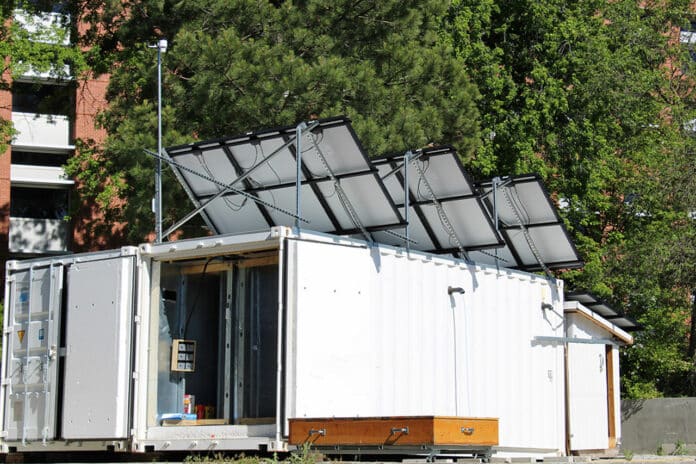Electricity demand for mechanical air conditioning (AC) is projected to double by 2050, driven by accelerating urbanization, primarily in hot and warm climates. Powering these units requires electricity, which is often generated by fossil fuels. This, in turn, leads to increased carbon emissions and further exacerbates the problem of global warming.
Therefore, finding cooling methods that don’t require putting more greenhouse gases into the air is crucial to helping a growing population adapt to climate change.
To find a sustainable solution and alternative to ACs, Washington State University researchers created the 60-square-foot chamber to test passive systems using wind towers and water evaporation instead of electricity to cool spaces.
The test chamber, which looks like a huge ship container, is solar-powered with battery storage and is completely independent of grid power. The chamber can be heated to a temperature range between 125 and 130 degrees Fahrenheit (52 and 54 degrees Celcius) year-round to test cooling innovations, measuring the temperature, humidity, and air velocity within and around a cooling system.
After conducting a full-scale experiment on a passive, downdraft cooling system under the hot, dry conditions of Phoenix, Arizona, the researchers calibrated the chamber using the results.
“We can simulate extreme conditions,” said Al-Hassawi, assistant professor in WSU’s School of Design and Construction. “With smaller scale models, we can also do much quicker tests and get results sooner than having to wait on large-scale prototype construction.”
Passive cooling systems that don’t require electricity have been used for centuries by people in hot places. One cooling strategy involves capturing breezes from a wind tower. With a layer of moisture at the top of the tower, evaporation cools the air, which then becomes heavier and sinks by gravity into a living space below. The moisture can be provided by wetted pads, shower heads, or misting nozzles, which is really interesting.
“It’s an older technology, but there’s been an attempt to innovate and use a mix of new and existing technologies to improve performance and the cooling capacity of these systems,” said Al-Hassawi.
Wider adoption of such passive cooling systems could lower energy demand. However, researching and testing passive cooling systems takes considerable investment and training.
“That’s why research like this would really help,” he said in the press release. “How can we address building design, revive some of these more ancient strategies, and include them in contemporary building construction? The test chamber becomes a platform to do this.”
Future studies in the chamber will involve the development of passive cooling in general, specifically passive downdraft cooling through rapid prototyping and design iteration of innovative multi-stage downdraft cooling systems, maximizing the potential of reduced-scale investigation.
Journal reference:
- Omar Dhia Al-Hassawi, and David Drake. Innovations in Passive Downdraft Cooling Performance Evaluation Methods: Design and Construction of a Novel Environmental Test Chamber. Energies, 2023; DOI: 10.3390/en16114371
